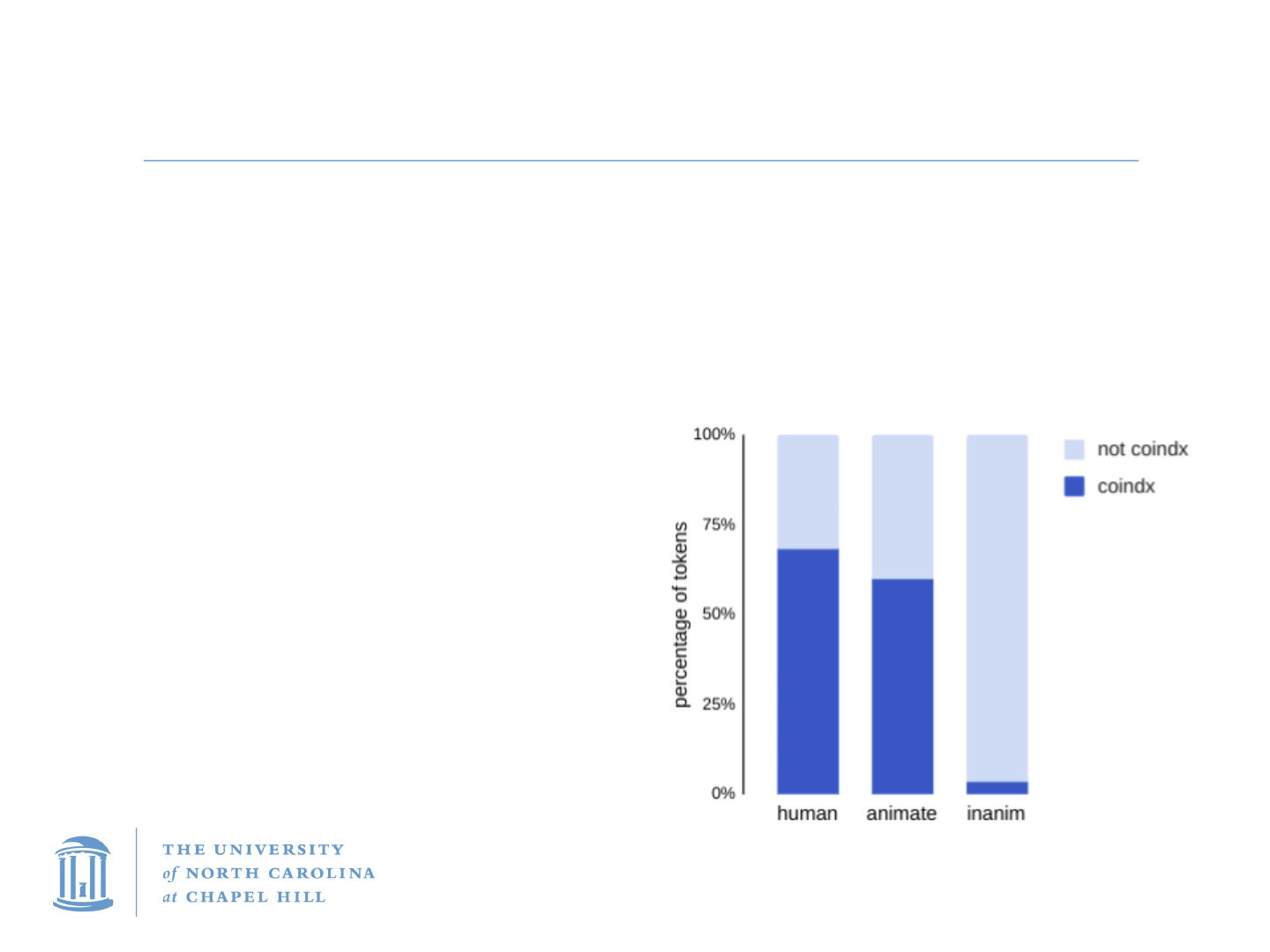
1
How much overt agreement
is needed for polysynthesis?
Quantitative evidence from
Cherokee.
Erin Humphreys & Brian Hsu (UNC-Chapel Hill)
Penn Linguistics Conference 48
March 2024
Slides online: hsub.web.unc.edu

2
1. Overview
2. Polysynthesis & agreement
3. Cherokee word order & agreement
4. Quantitative analysis
5. Implications & conclusion
Slides online: hsub.web.unc.edu

3
1. Overview
Two properties that cluster in polysynthetic
languages (Jelinek 1984, Baker 1996, Mithun 2017 a.o.):
§ Flexible clausal word order
• Often with free omission of argument NPs, non-
configurational properties (Hale 1983).
§ Polypersonal agreement: Coindexation of
multiple thematic arguments in verbal agreement
morphology
Slides online: hsub.web.unc.edu

4
1. Overview
This paper re-examines a standard generative
proposal on the causal relationship between
these properties (Jelinek 1984; Baker 1996; 2006).
We focus on key grammatical properties of
Cherokee (Southern Iroquoian: Oklahoma and North
Carolina).
Slides online: hsub.web.unc.edu

5
1. Overview
Key grammatical properties of Cherokee:
(i) Highly flexible clausal word order, with known
predictive factors (Scancarelli 1987; Hsu & Frey 2023)
Example: Agent arguments of transitive predicates
can precede or follow verbs.
(1) Subject < Verb
[gitli] ogi-sdawadvs-v.
dog 1.PL.EXCL-follow-EXPP
‘The dog followed us.’ (Feeling et al. 2017; 101)

6
1. Overview
Key grammatical properties of Cherokee:
(i) Highly flexible clausal word order, with known
predictive factors (Scancarelli 1987; Hsu & Frey 2023)
Example: Agent arguments of transitive predicates
can precede or follow verbs.
(2) Verb < Subject
a-n-adasdelis-g-o [yvwi j-u-n-asdi].
3-PL-help-PROG-HAB people DST-3-PL-little
‘The little people help (others).’ (Feeling et al. 2017; 43)

7
1. Overview
Key grammatical properties of Cherokee:
(ii) Fewer NP arguments coindexed by verbal
agreement than in other polysynthetic languages
(3) [sagwu=no] [j-un-atana ahwi] d-a-hih-e.
one=CN DST-3.PL-big deer DST-3.SG-kill-REPP
‘One (of the hunters) killed big deer.’ (Feeling et al. 2017; 53)
• Features of only one 3
rd
-person argument expressed
on the pronominal prefix a-.

8
1. Overview
We present a quantitative investigation of the
relation between overt coindexation of arguments
and NP placement in Cherokee clauses.
Main result: Argument NP placement does not vary,
based on whether its features are overtly coindexed.
Having fewer coindexed arguments does not lead to
reduced word order flexibility relative to other
polysynthetic languages (ex. Mohawk)

9
1. Overview
Proposal: The threshold for maintaining this type of word
order flexibility is abstract polypersonal agreement, rather
than surface polypersonal agreement (our terms)
Surface polypersonal agreement
Agreement morphology directly expresses features of
multiple arguments of a verb.
Abstract polypersonal agreement
Agreement morphology systematically depends
on relative properties of multiple arguments of a
verb (not all argument features directly expressed).

10
1. Overview
2. Polysynthesis & agreement
3. Cherokee word order & agreement
4. Quantitative analysis
5. Implications & conclusion

11
2. Polysynthesis & agreement
Next slides: Summary of Baker's (1996) analysis of
Mohawk (Northern Iroquoian), and the relation
between polypersonal agreement and flexible word
order.

12
2. Polysynthesis & agreement
Mohawk: Flexible clausal word order.
S V O
(4)a. Sak ra-núhwe’-s ako-[a]tyá'tawi
Sak MsS-like-HAB FSP-dress
'Sak likes her dress'
(Baker 1996; 10)

13
2. Polysynthesis & agreement
Mohawk: Flexible clausal word order.
V S O
(4)b. ra-núhwe’-s Sak ako-[a]tyá'tawi
MsS-like-HAB Sak FsP-dress
'Sak likes her dress'
(Baker 1996; 10)

14
2. Polysynthesis & agreement
Mohawk: Flexible clausal word order.
S O V
(4)c. Sak ako-[a]tyá'tawi ra-núhwe'-s
Sak FsP-dress MsS-like-HAB
'Sak likes her dress'
(Baker 1996; 10)

15
2. Polysynthesis & agreement
Mohawk: Flexible clausal word order.
V O S
(4)d. ra-núhwe’-s ako-[a]tyá'tawi Sak
MsS-like-HAB FsP-dress Sak
'Sak likes her dress'
(Baker 1996; 10)

16
2. Polysynthesis & agreement
Mohawk: Flexible clausal word order.
O V S
(4)e. ako-[a]tyá'tawi ra-núhwe’-s Sak
FsP-dress MsS-like-HAB Sak
'Sak likes her dress'
(Baker 1996; 10)

17
2. Polysynthesis & agreement
Mohawk: Flexible clausal word order.
O S V
(4)f. ako-[a]tyá'tawi Sak ra-núhwe'-s
FsP-dress Sak MsS-like-HAB
'Sak likes her dress'
(Baker 1996; 10)

18
2. Polysynthesis & agreement
Mohawk: Flexible clausal word order.
Other non-configurational properties (Baker 1996):
§ Absence of weak cross-over effects
§ Free omission of non-pronominal NP arguments

19
2. Polysynthesis & agreement
Mohawk: Verbal agreement prefixes coindex
features of up to two thematic arguments (including
two 3
rd
-person arguments)
§ Shako- expresses gender, number properties of two
arguments (masc. sg. subject, fem. object)
(5) Shako-nuhwe’-s (ne owira’a) Mohawk (Baker 1996; 21)
MSS/FO-like-HAB NE baby
‘He likes them (babies)’

20
2. Polysynthesis & agreement
Mohawk: Productive noun incorporation (cf. Mithun
2017b), in complementary distribution with
pronominal object agreement
(6) Ra-wir-a-nuhwe’-s Mohawk (Baker 1996; 21)
MSS-baby-ø-like-HAB
‘He likes babies’
§ Baker (1996): Incorporated objects fill the
"slot" taken by object agreement.

21
2. Polysynthesis & agreement
Baker's proposed condition on agreement, argument
licensing in polysynthetic languages:
The Morphological Visibility Condition (MVC)
A phrase X is visible for θ-role assignment from a head Y
only if it is coindexed with a morpheme in the word
containing Y via:
An agreement relationship, or
A movement relationship
(Baker 1996; 17)

22
2. Polysynthesis & agreement
Baker (1996): If this condition is met, all non-
pronominal NPs pattern as adjuncts: they can be
freely omitted, freely ordered.
[In a certain class of languages], a verb [Y] agrees with an
overt NP [X] if and only if [X] is in a dislocated, adjunct
position.
(Baker 2006: 290)

23
2. Polysynthesis & agreement
Verbs do not overtly coindex all argument features in
all polysynthetic languages with flexible word order.
How does the MVC accommodate this?
§ The MVC tolerates some degree of phonologically
null agreement (Baker 1996):
o Some argument features, or combinations thereof,
can be expressed by a null (∅) agreement morpheme.
o i.e. Particular cells in the paradigm are expressed as ∅

24
2. Polysynthesis & agreement
Verbs do not overtly coindex all argument features in
all polysynthetic languages with flexible word order.
How does the MVC accommodate this?
§ The MVC tolerates some degree of phonologically
null agreement (Baker 1996):
o The structural position of arguments indexed by null
(∅) agreement morphemes does not differ from
arguments indexed overtly (Baker 2006).

25
2. Polysynthesis & agreement
Our question: How much overt agreement is
necessary to maintain general word order freedom,
general polysynthetic characteristics?
Next sections: Quantitative evidence from Cherokee
shows that abstract polypersonal agreement is
sufficient to satisfy the MVC.

26
1. Overview
2. Polysynthesis & agreement
3. Cherokee word order & agreement
4. Quantitative analysis
5. Implications & conclusion

27
3. Cherokee word order & agreement
Language background: Southern Iroquoian
language, once spoken throughout lower
Appalachian regions.
Most speakers (~2000 native/fluent) now reside in
Oklahoma and Western North Carolina.
Next slides: Key aspects of clausal word order,
agreement morphology.

28
3. Cherokee word order & agreement
Flexible clausal word order:
§ All orders of subject, object, verb are grammatical
(Pulte & Feeling 1975, Scancarelli 1987).
(7) Subject < Verb
[gitli] ogi-sdawadvs-v.
dog 1.PL.EXCL-follow-EXPP
‘The dog followed us.’ (Feeling et al. 2017; 101)

29
3. Cherokee word order & agreement
Flexible clausal word order:
§ All orders of subject, object, verb are grammatical
(Pulte & Feeling 1975, Scancarelli 1987).
(8) Verb < Subject
a-n-adasdelis-g-o [yvwi j-u-n-asdi].
3-PL-help-PROG-HAB people DST-3-PL-little
‘The little people help (others).’ (Feeling et al. 2017; 43)

30
3. Cherokee word order & agreement
Flexible clausal word order:
§ All orders of subject, object, verb are grammatical
(Pulte & Feeling 1975, Scancarelli 1987).
(9) Object < Verb
No kil [am] ji-todis-g-o
Then until water 1-heat.water-PROG-HAB
‘Then I heat some water.’ (Feeling et al. 2017; 129)

31
3. Cherokee word order & agreement
Flexible clausal word order:
§ All orders of subject, object, verb are grammatical
(Pulte & Feeling 1975, Scancarelli 1987).
(10) Verb < Object
u-sdu-hnv [galohisdi?i].
3-close-EXPP door
‘(he) closed the door.’ (Feeling et al. 2017; 35)

32
3. Cherokee word order & agreement
Flexible clausal word order:
§ Non-configurational properties shared with
Mohawk (Beghelli 1996)
• Absence of weak cross-over effects
• Free omission of non-pronominal NP arguments

33
3. Cherokee word order & agreement
Recent findings (Hsu & Frey 2023):
§ No subject/object asymmetry in word order:
o NP placement insensitive to number of NPs in clause:
o Ex: Themes of transitive verbs show same placement
as themes of unaccusative verbs.
§ Placement of each NP determined probabilistically
by its properties related to contrast, referential
accessibility and thematic role.

34
3. Cherokee word order & agreement
Recent findings (Hsu & Frey 2023):
§ Word order principles qualitatively similar
to clausal word order in related Nothern Iroquoian
languages:
• Mohawk (Baker 1996; Mithun 2017b)
• Cayuga (Mithun 1992)
• Tuscarora (Mithun 1995)

35
3. Cherokee word order & agreement
Pronominal agreement system:
§ All verbs have one pronominal prefix
o Person and number properties of at least one
argument are indexed
o No paradigmatic gaps, all combinations of person and
number are available.
§ If both arguments are local (1st person, 2nd
person), features of both, and their relative
thematic prominence, are expressed by the prefix

36
3. Cherokee word order & agreement
Pronominal agreement system:
§ If both arguments are local (1
st
or 2
nd
person): features of both, and their relative
thematic prominence, are expressed by the prefix
(11) hi? da-jv-nej-el-i.
this FUT-1SG/2PL-tell-DAT-FUT
‘I will tell you about this’
(Feeling et al. 2017; 75)

37
3. Cherokee word order & agreement
Pronominal agreement system:
§ If one argument is local, and the other is not: the
prefix expresses features of the local argument
o Regardless of relative thematic prominence of the
arguments

38
3. Cherokee word order & agreement
Pronominal agreement system:
§ If one argument is local, and the other is not: the
prefix expresses features of the local argument
o Regardless of relative thematic prominence of the
arguments
(12) [gitli] ogi-sdawadvs-v.
dog 1.PL.EXCL-follow-EXPP
‘The dog followed us.’
(Feeling et al. 2017; 101)

39
3. Cherokee word order & agreement
Pronominal agreement system:
§ If both arguments are 3rd person: The prefix
expresses number features of the more animate
argument
o If they are equally animate, the more thematically
prominent argument is overtly agreed with
(13) [sagwu=no] [j-un-atana ahwi] d-a-hih-e.
one=CN DST-3.PL-big deer DST-3.SG-kill-REPP
‘One (of the hunters) killed big deer.’
(Feeling et al. 2017; 53)

40
3. Cherokee word order & agreement
Pronominal agreement system:
§ If both arguments are 3rd person: The prefix
expresses number features of the more animate
argument.
o If they are equally animate, the more thematically
prominent argument is overtly agreed with
(14) [ijul] y-uni-kevs-e
both NONFIN-3.PL-chase-REPP
‘(The bull) would chase them both.’
(Feeling et al. 2017; 114)

41
3. Cherokee word order & agreement
§ Mohawk: Features of two 3rd person arguments
can be expressed on a pronominal prefix.
o (Baker 1996; 191; Mithun 2017b; 33)
§ Cherokee: Features of two 3rd person arguments
are never simultaneously expressed on a prefix.
o Pronominal prefixes on transitive verbs are only
partially informative about the features of the non-
coindexed argument.
o Ex. A 3rd person prefix on a transitive verb only
indicates that the other argument is not local

42
3. Cherokee word order & agreement
§ Cherokee only consistently expresses features of
one argument of a transitive verb.
o Unlike Mohawk
§ There is no productive noun incorporation
o Also unlike Mohawk

43
1. Cherokee word order & agreement
A proposed distinction among polypersonal
agreement systems:
Surface polypersonal agreement
Agreement morphology directly expresses features of
multiple arguments of a verb
Abstract polypersonal agreement
Agreement morphology systematically depends
on relative properties of multiple arguments of a
verb (not all argument features directly expressed)

44
3. Cherokee word order & agreement
Pronominal prefixes in Cherokee typically express
features of only one argument of transitive verb.
§ Few patterns of surface polypersonal
agreement, compared to Mohawk.
However, the choice of which argument to coindex
depends on relative properties of more than one
thematic argument.
§ Evidence for abstract polypersonal agreeement.

45
3. Cherokee word order & agreement
Next section: Does this reduced amount of visible
argument features on verbs result in a distinct
structural representation of NPs in the clause?
Or, is abstract polypersonal agreement sufficient to
maintain word order flexibility?

46
3. Cherokee word order & agreement
Interim summary
§ Cherokee has less overt coindexation than the
other Iroquoian languages
o Taken as the "prototypical examples of polysynthesis"
(Mithun 2017b; 747)
§ We know what predicts word order in Cherokee
We use Cherokee to test hypotheses about the
relationship between word order flexibility and
morphology

47
3. Cherokee word order & agreement
If Surface Polypersonal Agreement is needed to satisfy
the MVC...
Whether or not an argument is overtly agreed with will
significantly affect its position in the clause.
If Abstract Polypersonal Agreement meets the
agreement threshold for the MVC...
Whether an argument is overtly agreed with will have no
significant effect on its position in the clause.

48
1. Overview
2. Polysynthesis & agreement
3. Cherokee word order & agreement
4. Quantitative analysis
5. Implications & conclusion

49
4. Quantitative analysis
Hsu and Frey (2023) identify factors that best predict
clausal word order in Cherokee:
§ All non-pronominal NPs in a corpus are tagged for a
range of grammatical properties.
Two word order factors found to be significant in
predicting the placement of NPs:
§ Thematic role
§ Referential accessibility (a.k.a. newness / givenness)

50
4. Quantitative analysis
Probabilistic tendencies of Cherokee word order in
relation to thematic role and referential accessibility:
(Hsu & Frey 2023)
NP is an agent
NP is a theme
NP is new
92%
preverbal
(12/13)
73%
preverbal
(36/49)
NP is given
76%
preverbal
(37/49)
50%
preverbal
(57/114)

51
4. Quantitative analysis
This paper: We expand the Hsu & Frey corpus by
tagging all NPs for whether their features are
coindexed by a pronominal prefix on the verb.
We can thus identify whether overt coindexation on
a pronominal prefix influences placement of NP
arguments of transitive verbs.
§ On intransitive verbs, features of the sole
argument NP are always coindexed.

52
4. Quantitative analysis
We control for factors that influence NP placement,
and/or argument coindexation:
§ Thematic role affects word order and
coindexation
§ Argument animacy affects only coindexation
§ Referential accessibility affects only word order
(Montgomery-Anderson 2015; Hsu & Frey 2023)

53
4. Quantitative analysis
Agent NPs are coindexed significantly more than
themes are. It also has a word order effect: agent NPs
are likelier to precede verbs than themes (H&F 2023)
X-squared = 67.803,
df = 1,
p-value < 2.2e
-16

54
4. Quantitative analysis
When controlling for thematic role: No
significant effect of coindexation on NP position.
X-squared = 0.040695,
df = 1,
p-value = 0.8401
Figure: Placement of theme NPs
only, by coindexed vs. non-
coindexed status.

55
4. Quantitative analysis
Animacy significantly affects which arguments are
coindexed but not word order.
X-squared = 170.01,
df = 2,
p-value < 2.2e-16

56
4. Quantitative analysis
When controlling for animacy contrasts: No
significant effect of coindexation on NP position.
X-squared = 0.021634,
df = 1,
p-value = 0.8831
Figure: Placement of animate NPs
only, by coindexed vs. non-
coindexed status.

57
4. Quantitative analysis
Referential accessibility does not significantly affect
which argument is indexed. It does have word order
effects; discourse-new NPs likelier to precede verbs
than given NPs (H&F 2023)
X-squared = 0.5467,
df = 1,
p-value = 0.4597

58
4. Quantitative analysis
When controlling for referential accessibility: No
significant effect of coindexation on NP position.
X-squared = 0.0038223,
df = 1,
p-value = 0.9507
Figure: Placement of discourse-
given NPs only, by coindexed vs.
non-coindexed status.

59
4. Quantitative analysis
The placement of an argument NP in relation to a
verb does not depend on whether its features are
visibly coindexed by a pronominal prefix
In Cherokee, non-coindexed arguments appear to
have the same structural status as coindexed
arguments

60
1. Overview
2. Polysynthesis & agreement
3. Cherokee word order & agreement
4. Quantitative analysis
5. Implications & conclusion

61
5. Implications & conclusion
Cherokee does not have less word order freedom
than other polysynthetic languages, while showing
overt agreement with systematically fewer
arguments.
Abstract polypersonal agreement is sufficient to meet
the agreement threshold for maintaining general
polysynthetic properties.

62
5. Implications & conclusion
What does this mean for the MVC?
Baker (2006): Nonvisibly-coindexed NPs show flexible
placement if their features happen to be expressed by a
null affix (∅ represents a slot in the agreement paradigm)
Cherokee agreement is hard to characterize as such:
Whether features of an NP are coindexed depends on
relative properties of two arguments.

63
5. Implications & conclusion
What does this mean for the MVC?
Crucially, verbal agreement in Cherokee requires all NP
arguments to be visible to the verb, in order to determine
which features are coindexed.
§ Can be modeled by Multiple Agree between verbs and
argument NPs (Oxford 2019).
A one argument to one affix correspondence is not
strictly required.

64
5. Implications & conclusion
The Morphological Visibility Condition (MVC)
A phrase X is visible for θ-role assignment from a head
Y only if it is coindexed with a morpheme in the
word containing Y via:
An agreement relationship*, or
A movement relationship
(Baker 1996; 17)
*abstract polypersonal agreement is sufficient to meet
this threshold

65
5. Implications & conclusion
Summary of main results:
§ NP placement in the Cherokee clause does not depend
on whether its features are visibly coindexed on a
pronominal prefix.
§ Abstract polypersonal agreement is sufficient to
maintain free word order in polysynthetic languages

66
5. Implications & conclusion
Future directions:
§ More quantitative analysis of word order predictors in
polysynthetic languages and/or languages with flexible
word order.
§ How much can languages vary in the movement-
triggering propensities of particular features? Is it
predicted by any (morphological) properties?

67
Thank you!
Slides online: hsub.web.unc.edu

68
References
Adger, David., Daniel Harbour, and Laurel J. Watkins. 2009. Mirrors and
macroparameters. Cambridge University Press.
Akkus, Faruk. 2018. Copular constructions and clausal syntax in Cherokee.
In Proceedings of the Workshop on the Structure and Constituency of
Languages of the Americas 21, University of British Columbia Working
Papers in Linguistics 46, ed. Megan Keough, Natalie Weber, Andrei
Anghelescu, Sihwei Chen, Erin Guntly, Khia Johnson, Daniel Reisinger,
and Oksana Tkachman.
Beghelli, Filippo. 1996. Cherokee clause structure. In Cherokee papers from
UCLA, ed. Filippo Beghelli, Barbara Blankenship, Michael Dukes, Edward
S. Flemming, Pamela Munro, Brian Potter, Robert S. Williams, and
Richard Wright, 105–114. Los Angeles: Department of Linguistics,
University of California Los Angeles.
Baker, Mark. 1996. The polysynthesis parameter. Oxford: Oxford
University Press.

69
References
Baker, Mark. 2006. On zero agreement and polysynthesis. In Arguments
and Agreement, ed. Peter Ackema, Patrick Brandt, Maaike
Schoorlemmer, and Fred Weerman, 289-342. Oxford Univeristy Press.
Chomsky, Noam. 1993. A minimalist program for linguistic theory. In The
View from Building 20, ed. Kenneth Hale and Samuel Jay Keyser, 1–52.
Cambridge, MA: MIT Press.
Dipper, Stefanie, Michael Götze, and Stavros Skopeteas, ed. 2007.
Information structure in cross-linguistic corpora: Annotation guidelines
for phonology, morphology, syntax, semantics, and information
structure (ISIS Working Papers of the SFB 632). Potsdam:
Universitätsverlag.
Feeling, Durbin, and William Pulte. 1975. Cherokee-English dictionary.
Talequah: Cherokee Nation of Oklahoma.

70
References
Frey, Benjamin. 2020. “Data is nice:” Theoretical and pedagogical
implications of an Eastern Cherokee corpus. In Collaborative
approaches to the challenge of language documentation and conservation:
Selected papers from the 2018 Symposium on American Indian Languages
(SAIL), ed. Wilson de Lima Silva and Katherine Riestenberg, 38–53.
Honolulu: University of Hawai’i Press.
Hale, Kenneth. 1983. Warlpiri and the grammar of non-configurational
languages. Natural Language & Linguistic Theory 1, 5–47.
Harbour, Daniel, Laurel J. Watkins, and David Adger. 2012. Information
structure, discourse structure, and noun phrase position in Kiowa.
International Journal of American Linguistics 78: 97–126.
Hsu, Brian, and Benjamin Frey. 2023. Word order in Cherokee:
information structure, thematic structure, and variability. Ms.,
University of North Carolina at Chapel Hill.

71
References
Jelinek, Eloise. 1984. Empty categories, case, and configurationality. NLLT
2: 39–76.
Jelinek, Eloise. 2006. The Pronominal Argument Parameter. In Arguments
and Agreement, ed. Peter Ackema, Patrick Brandt, Maaike
Schoorlemmer, and Fred Weerman, 261–288. Oxford University Press.
Mithun, Marianne. 1992. Is basic word order universal? In Pragmatics of
word order flexibility, ed. Doris L. Payne, 15–62. Amsterdam: John
Benjamins.
Mithun, Marianne. 1995. Morphological and prosodic forces shaping word
order. In Word order in discourse, ed. Pamela A. Downing and Michael
Noonan, 387–423. Amsterdam/Philadelphia.
Mithun, Marianne. 2017a. Argument marking in the polysynthetic verb
and its implications. In The Oxford handbook of polysynthesis, ed.
Michael Fortescue, Marianne Mithun, and Nicholas Evans, 30–58.
Oxford University Press

72
References
Mithun, Marianne. 2017b. The Iroquoian language family. In The
Cambridge handbook of linguistic typology, ed. Alexandra Y. Aikhenvald,
747–781. Cambridge University Press.
Montgomery-Anderson, Brad. 2008. A reference grammar of Oklahoma
Cherokee. Ph.D dissertation. University of Kansas.
Montgomery-Anderson, Brad. 2015. Cherokee Reference Grammar.
Norman: University of Oklahoma Press.
Oxford, Will. 2019. Inverse marking and multiple agree in algonquin:
Complementarity and variability. Natural Language & Linguistic
Theory, 37(3), 955–996.
Posit team. 2023. RStudio: Integrated Development Environment for
R. Posit Software, PBC, Boston, MA. URL http://www.posit.co/.

73
References
R Core Team. 2023. R: A Language and Environment for Statistical
Computing. R Foundation for Statistical Computing, Vienna, Austria.
<https://www.R-project.org/>.
Scancarelli, Janine. 1986. Pragmatic roles in Cherokee grammar. In
Proceedings of the Twelfth Annual Meeting of the Berkeley Linguistics
Society, ed. Vassiliki Nikiforidou, Mary VanClay, Mary Niepokuj, and
Deborah Feder, 224–234. Berkeley: Berkeley Linguistics Society.
Wickham, H. et al. (2019). Welcome to the tidyverse. Journal of Open Source
Software, 4(43), 1686, doi:10.21105/joss.01686
